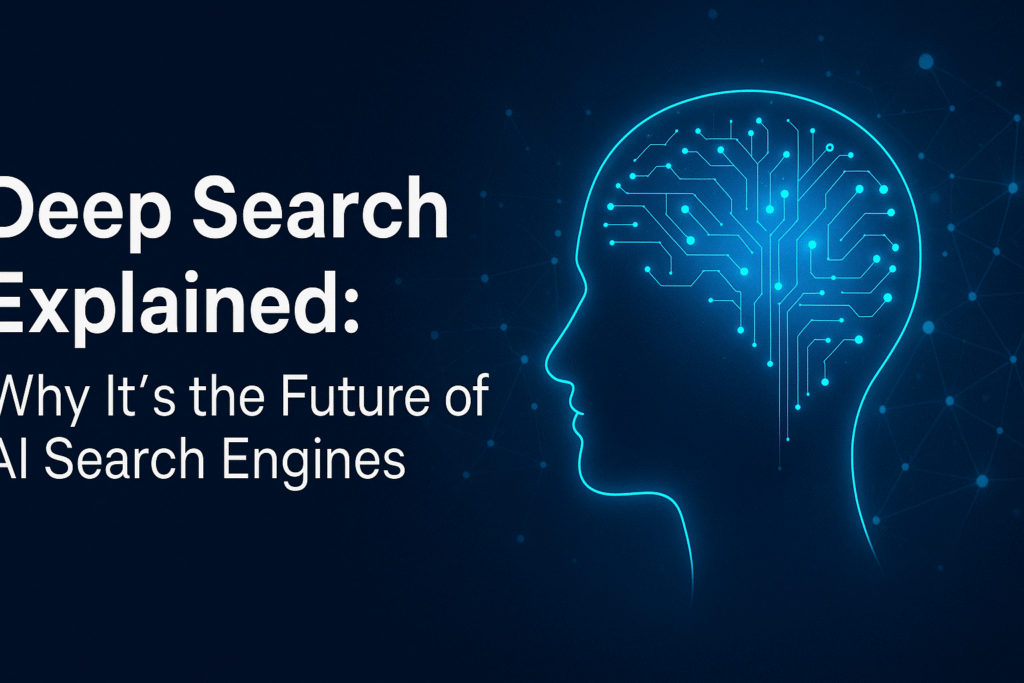Deep Search Explained: Why It’s the Future of AI Search Engines (ChatGPT, Gemini, Grok, Claude, DeepSeek, and Copilot Compared)
1. Hook + Introduction
Imagine this: You’re prepping for a product launch. Time is ticking. You type a complex query into your usual search engine, and it spits back ten blue links. You click one… skim… backtrack… open another… repeat. Frustrating, right?
Now imagine asking the same query to an AI search engine—and instantly getting a contextual, summarized answer tailored to your needs, drawing from multiple sources, remembering your past queries, and suggesting next steps. That’s Deep Search in action.
We’re at a massive inflection point. Traditional keyword-based search engines—the backbone of internet discovery for over two decades—are evolving. Or more accurately, they’re being replaced.
Enter Deep Search, a new paradigm for knowledge access and AI-native interaction.
It’s not just a buzzword. Deep Search represents the fusion of semantic understanding, contextual awareness, and real-time generation. It leverages large language models (LLMs), vector databases, and retrieval-augmented generation (RAG) to pull not just information, but insights from the web, your data, and even your memory.
In this article, we’ll explore what Deep Search actually is, why it’s the future of AI-powered discovery, and how leading players—ChatGPT, Gemini, Grok, Claude, DeepSeek, and Copilot—stack up in this next-gen landscape.
2. What Is Deep Search?
Deep Search is a next-gen search methodology that goes beyond keyword matching. Unlike traditional search engines, which index and retrieve documents based on keyword relevance, Deep Search understands intent, context, and meaning.
Deep Search vs Traditional Search
| Feature | Traditional Search | Deep Search |
|---|---|---|
| Query Type | Keywords | Natural Language |
| Result Type | Hyperlinks | Direct Answers |
| Memory | Stateless | Context-Aware |
| Depth | Surface-level | Insight-level |
| Tech | Index-based | LLM + Vector Search |
Core Technologies Behind Deep Search:
Semantic Understanding: Interprets meaning, not just words.
LLMs (Large Language Models): Power natural conversations and reasoning.
Vector Databases (e.g., Pinecone, Weaviate): Store embeddings for semantic recall.
Retrieval-Augmented Generation (RAG): Retrieves documents and combines them with AI generation.
Contextual Memory: Remembers past queries and adapts accordingly.
For example, ask “What are Elon Musk’s AI ventures?” and a traditional search may list articles. Deep Search will explain Neuralink, xAI, Tesla AI, and Grok—summarizing each, citing sources, and offering follow-up questions.
That’s not a Google search. That’s knowledge orchestration.
3. Why Deep Search Matters
Deep Search is a game-changer across industries.
Education
Students and teachers can skip the click-through chaos. Instead of reading five sources to understand the French Revolution, they get one coherent summary, complete with visuals and citations.
Research
Academic professionals can retrieve papers, extract key findings, and even ask follow-up questions—turning hours of manual search into minutes.
Coding & Development
With tools like Copilot and ChatGPT, developers can ask questions like “What’s the best way to debounce a function in React?” and get code plus explanation plus real-time debugging tips.
Customer Support
Instead of FAQs and forum hopping, customers get one-stop resolution. AI agents use Deep Search to query internal documents, CRM data, and past tickets.
Business Intelligence
Founders, consultants, and executives can query financial reports, market trends, and case studies to make faster decisions.
It’s not just about answers. It’s about insights.
4. Meet the Key Players in Deep Search
1. ChatGPT (OpenAI)
Core Strengths: Natural language prowess, GPT-4 Turbo, plugins, memory.
Web Access: With Browse w/ Bing and plugins.
Complex Queries: Excellent at multi-step reasoning.
UX: Clean, conversational, customizable GPTs.
Use Cases: Tutoring, coding, planning, writing.
2. Gemini (Google DeepMind)
Core Strengths: Natively fused with Google Search, Bard.
Web Access: Deep integration with live Google data.
Context Handling: Advanced context chaining.
UX: Search + AI hybrid UI.
Use Cases: Real-time research, knowledge queries.
3. Grok (xAI / Elon Musk)
Core Strengths: Real-time access to X (Twitter), humor-infused tone.
Web Access: Strong on social data, limited breadth.
Context Handling: Decent, not memory-persistent yet.
UX: Twitter-native, fast-paced.
Use Cases: Trend spotting, culture tracking.
4. Claude (Anthropic)
Core Strengths: Long context window (100k+ tokens), safe-by-design.
Web Access: Limited, but expanding.
Context Handling: Extremely robust.
UX: Lightweight, clean.
Use Cases: Document analysis, longform reasoning.
5. DeepSeek (Open Source / China)
Core Strengths: Open weights, cutting-edge research architecture.
Web Access: Depends on deployment.
Context Handling: Advancing fast.
UX: Varies by implementation.
Use Cases: Academic research, regional applications, language-specific tasks.
6. Copilot (GitHub/Microsoft)
Core Strengths: Coding assistant, IDE integration, context-aware.
Web Access: Via Bing integration (GitHub Copilot X).
Context Handling: Project-aware, inline.
UX: Developer-first, autocomplete style.
Use Cases: Code completion, debugging, documentation.
5. Deep Search Comparison Table
| Tool | Response Depth | Memory/Context | Web Access | Ideal Use Case | Free Tier |
|---|---|---|---|---|---|
| ChatGPT | ⭐⭐⭐⭐⭐ | Yes | Yes (Pro) | All-around | Limited |
| Gemini | ⭐⭐⭐⭐ | Yes | Yes | Research | Free & Paid |
| Grok | ⭐⭐⭐ | No | Yes (X data) | Trends | Paid (Premium X) |
| Claude | ⭐⭐⭐⭐⭐ | Yes | Limited | Long docs | Free & Paid |
| DeepSeek | ⭐⭐⭐⭐ | Varies | Varies | Academic | Open Source |
| Copilot | ⭐⭐⭐⭐ | Yes | Limited | Dev workflows | Paid |
6. The Future of Deep Search
Here’s where things get exciting.
Multimodal Search: Combine voice, text, images, video, and code into one search experience.
Personal Agents: Persistent AI that remembers your projects, plans, and preferences.
Integrated Workflows: From querying to execution—search, plan, write, build, automate.
Decentralized Indexing: Open-source LLMs like DeepSeek could challenge centralized giants.
B2B + Enterprise: Internal Deep Search across documents, wikis, CRM, emails.
Healthcare + Legal: Precision querying for compliance, diagnosis, risk analysis.
Deep Search is the brain. Agents are the body. Workflows are the soul.
Ultimately, Deep Search is the gateway to AGI (Artificial General Intelligence). It’s how machines learn to reason, not just retrieve.
7. Final Thoughts
We’re not searching anymore. We’re conversing, investigating, co-creating.
If you haven’t tried Deep Search yet, start with ChatGPT or Gemini. Explore Claude for deep reads. Use Copilot if you’re a dev. If you’re adventurous, experiment with DeepSeek models.
The old paradigm was “search and sift.” The new one is “ask and act.”
Here’s what to do next:
Test at least two Deep Search tools this week.
Integrate one into your daily workflow.
Subscribe to updates—this field is evolving fast.
Caution:
Be mindful of bias, hallucinations, and data privacy.
Trust but verify. Use Deep Search to accelerate, not replace, human judgment.
Deep Search isn’t just a new way to look for answers. It’s the beginning of a new era of understanding.
FAQ
Q: Is Deep Search replacing Google? A: Not yet. But it’s augmenting or even replacing how power users interact with knowledge.
Q: Can Deep Search tools access real-time data? A: Many can—ChatGPT with browsing, Gemini by default, and Grok via X.
Q: Are these tools safe to use for sensitive information? A: Use caution. Always check each tool’s privacy policy before sharing confidential info.
Q: Which Deep Search tool is best for beginners? A: ChatGPT or Gemini are great starting points due to their wide access and intuitive interfaces.
Q: Will Deep Search help in education? A: Hugely. Students can get summarized, contextual learning experiences instantly.


